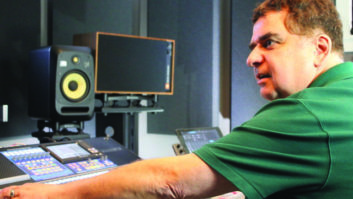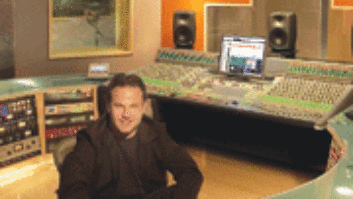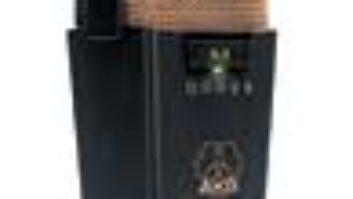
Supersonic’s Live Room yields tones ranging from sweet to reflective.
Hybrid has become a 2005 buzzword, what with auto manufacturers from Honda to Toyota sending more eco-friendly vehicles into the fast lane. Now, with the opening of forward-thinking facilities such as producer/engineer Gustavo Celis’ Supersonic Studios (www.supersonicstudios.com), the recording industry has its own hybrid model: comparably efficient, but with considerably more legroom than a Prius or Insight.
Based in Miami and launched late last year, Supersonic combines the virtually limitless capabilities of a digital console/workstation combo with the unsurpassed sound of vintage and contemporary outboard gear. Celis isn’t the first engineer to integrate in- and out-of-the-box equipment, but his studio was born from this idea and is one of the few to take it to such an extreme level.
“I was working out of my house and collecting [analog gear] little by little,” says Celis, who has three Grammys and albums by Ricky Martin, Mandy Moore, Shakira and the film Chicago (which earned a Best Sound Oscar) to his credit. “I also do a lot of mixing in Pro Tools and found that it was really easy to use both.”

Gustavo Celis
Most of his inventory sat dormant while he worked at other studios, so he decided to build “a world-class facility that I could use for myself, but if I weren’t there, it could be rented out.”
Celis hired Toronto-based Pilchner-Schoustal to design his new 1,350-square-foot space, which began a two-year construction process (built by studio manager Jamie Graf; Geoff Goddard, fabric fitting) that was worth the wait, considering it allowed Celis to acquire two newly released products: the Digidesign ICON and Genelec’s new 8000 MDE Series monitors. “The hybrid idea basically was incomplete without a console like the ICON,” says Celis. “It seemed like the room was designed for that console from the beginning. But it was actually based around a modified ProControl.”
The 32-fader ICON D-Control console (with 7.1 monitoring) resides in Control 1, along with a Pro Tools|HD7 Accel with 64-bit expansion chassis, three 192 and six 96 I/O interfaces, DigiDelivery LT and ample Pro Tools plug-ins and other accessories.
Custom racks to either side of the console house Celis’ extensive outboard arsenal, all normaled to the Pro Tools configuration. “It’s a super-luxurious setup,” he says. “There’s a whole 192 interface just for digital reverbs. Everything has a dedicated I/O labeled by name so you don’t have to know, for example, that Neve #8 is connected to interface C, track 7. That’s too much math when all you need to do is EQ a vocal. If you need a compressor, you call it by name. It’s idiot-proof.”
Supersonic’s inventory includes vintage Neve mic pre/EQs (1073 and 1084s) and other key pieces from SSL, API, Earthworks, Universal Audio, Manley, Focusrite, Chandler, dbx, UREI and Teletronix, among others. The main monitor system employs a pair of Genelec 1034Bs with a 7073A sub, while the surround system features five Genelec 8050As — upgraded from a set of 1031As — and a Genelec 7070A LSE Series Active Subwoofer. The room also contains a pair of Yamaha NS-10s and SLS/Event 20/20, with Bryston 4B SST and Hafler 2500 amps. “The monitoring system, design and acoustics are so well-implemented, it feels like everywhere else the music is in black and white, but here, it’s in full color,” Celis says.
Though Supersonic was designed with surround mixing in mind, it’s amply suited for tracking; mic offerings include a Brauner VM1 Klaus Heyne Edition and numerous classic models. Its 16×25×14-foot Live Room and 6×9×10-foot Iso 1 feature maple floors and sight lines to Control 1 and Control/Iso 2, which is scheduled for a mid-2005 completion. A hybrid within a hybrid, Control/Iso 2 will contain a Pro Tools rig and 5.1 setup identical to Control 1, a digital control surface (to be determined) and various outboard gear, and can serve as either a second control room, edit bay or iso booth.
Lounge/Iso 3 also serves dual purposes: In addition to its comfortable furniture, a fully loaded I/O panel and data port enable clients to plug in a mic, Pro Tools rig or laptop for recording, editing or relaxing. All rooms, lounge included, embody a comfortable yet modern design that’s a result of wife Claudia’s interior design firm, Modernet Inc., and Pilchner Schoustal’s use of natural materials in their architectural plans. “The space is devoid of artificial surfaces,” says Martin Pilchner. “The idea was to use simple planes with subtle horizontal and vertical cues derived by the juxtaposition of surface finishes and lighting.”
Just as each room serves multiple purposes, Supersonic will serve Celis’ own projects, such as the new acts he’s developing for his forthcoming record label, and major-label projects such as Martin’s new album and Juvenile’s latest, Reality Check, which was mixed at Supersonic in stereo and 5.1 by Dave Junco.
“This is the most simple studio I’ve ever seen, yet it’s the most powerful one,” Celis concludes. “You can recall a tremendously complex mix in seconds because the I/O interface is normaled to the gear. If that’s not the long-term future, at least it’s the temporary future of bringing it all together.”




